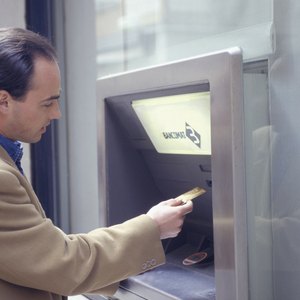
In the United States, there are approximately 400,000 automatic (or automated) teller machines, also known as ATMs. The ATM was perfected by Luther George Simjian, a New York inventor, who convinced a city bank in the 1930s that immediate check deposit from local workers would be an advantage to the bank. The experiment lasted only six months due to disinterest from the general working population. The modern ATM was used first in London in 1967, before the use exploded in the 1980s. Economists speculate that the decline in the number and use of the machines over the past few years is related to increased ATM fees.
Fraud
The potential for identity theft is a major disadvantage related to automatic teller machines. Fraudulent card readers, called skimmers, are placed over the authentic reader to transfer numbers and codes to nearby thieves. Spy cameras are also used by password voyeurs to collect access codes. Lost access cards are another potential for fraud. The Federal Trade Commission states that people are not responsible for unauthorized use of a card, if it is reported immediately. If the loss is not noticed immediately, consumers may lose all funds in an account, if notice is not given before money transfers are made. Incorrect withdrawals noted on monthly statements must be reported, or else consumers are responsible for the amounts, even when removed by fraudulent means, according to the U.S. Federal Trade Commission.
Theft
ATMs are a magnet for easy theft. Robbers are guaranteed cash from consumers visiting the money machines. Although ATM robberies are not common (only one attack in every 2.5 million transactions), according to the California Banking Industry, the U.S. Department of Justice (DOJ) reports that approximately 15 percent of people attacked and robbed at ATM stations are killed or injured. The DOJ claims the average loss is between $100 and $200.
Fiscal Planning Issues
As a safety measure, many ATMs list only the deposit or withdrawal amount and omit the balance from the account. People using an ATM for frequent banking are not informed of the total amount in the account when funds are withdrawn or deposited, as opposed to traditional checking which provides a register to maintain a running account of the balance. This lack of recording allows some customers to overdraw accounts, adding penalty charges.
Operation Issues
ATMs located in busy locations may not have adequate funds for busy holiday weekends when large numbers of people are taking out cash. Most machines require envelopes to deposit checks and cash, and these may also be in short supply, preventing customers from depositing funds. Damaged machines leave the bank client with no alternative during non-banking hours.
Bank Fees
As bank consolidation continues, fewer companies own ATMs, and they limit access to automated banking. U.S. Senator John Kerry states that two banks, Fleet Bank and BankBoston, operate nearly two thirds of all the ATMs in New England. This monopoly reduces competition. Kerry warns that "policy makers should be watchful of the capacity to which ATM surcharges become more prevalent." Reliance on automatic teller machines for personal banking means increases in bank fees. Most banks allow an unlimited number of withdrawals from same system ATMs, but charge a fee between $2 and $5 for withdrawals from machines outside the system.
References
Writer Bio
David B. Ryan has been a professional writer since 1989. His work includes various books, articles for "The Plain Dealer" in Cleveland and essays for Oxford University Press. Ryan holds degrees from the University of Cincinnati and Indiana University and certifications in emergency management and health disaster response.

